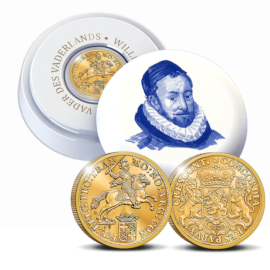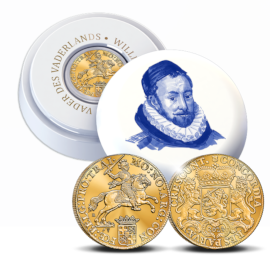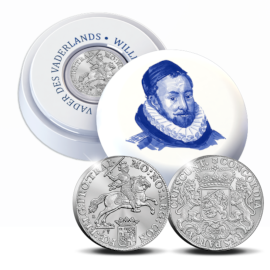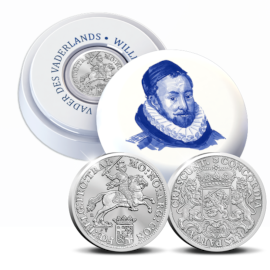The production process of Delft earthenware starts with the composition of the clay. It is made up of about 10 raw materials (for example kaolin, chalk, feldspar and quartz). The raw materials are carefully mixed according to special recipes until they form a liquid mass.

Official Restrike Ducaton 2024
View all issues
Official Restrike: Ducaton 2024 Gold 2 Ounce – Royal Delft Edition
Golden Restrike from 1584

Official Restrike: Ducaton 2024 Gold 1 Ounce – Royal Delft Edition
Golden Restrike from 1584

Official Restrike: Ducaton 2024 “Silver Rider” 1 Ounce – Royal Delft Edition
Silver Restrike from 1584

Official Restrike: Ducaton 2024 “Silver Rider” 2 Ounce – Royal Delft Edition
Silver Restrike from 1584

Step 5 – Decorating the coin holder
The Delftware painters then paint the Royal Delft decorations on the coin holders by hand. They use brushes made of the hairs of martens and squirrels, and black paint containing cobalt oxide. The cobalt brings about a chemical reaction during the firing process, changing the colour from black to (Delft) blue.
Step 6 - Glazing & Firing
The decorated coin holders are then glazed. The glaze covers the decoration with a non-transparent layer of white. Now the coin holder will be fired in the oven for 24 hours. During the second firing process, which is done at a temperature of 1200 °C (2192 °F), the glaze melts into a translucent layer of glass.
Step 7 – Quality check
The final step of our production process is the quality check. Every piece is inspected from top to bottom to decide it can be put to sale as a “Premium“ Royal Delft product. Royal Delft is the only remaining, original Delftware manufacturer from the 17th century. At the end of the 18thcentury, less attention was paid to Delft Blue, reason for which almost all potteries were forced to close down. When Joost Thooft took over the factory in 1876, he improved the production process in such a way making an even more beautiful and high quality product which brought Delfts Blue into a revival. Up to the present day Royal Delft uses this method of producing which is the worldwide standard of nowadays Delft Blue.
